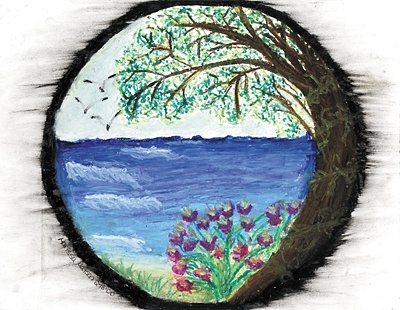All Nonfiction
- Bullying
- Books
- Academic
- Author Interviews
- Celebrity interviews
- College Articles
- College Essays
- Educator of the Year
- Heroes
- Interviews
- Memoir
- Personal Experience
- Sports
- Travel & Culture
All Opinions
- Bullying
- Current Events / Politics
- Discrimination
- Drugs / Alcohol / Smoking
- Entertainment / Celebrities
- Environment
- Love / Relationships
- Movies / Music / TV
- Pop Culture / Trends
- School / College
- Social Issues / Civics
- Spirituality / Religion
- Sports / Hobbies
All Hot Topics
- Bullying
- Community Service
- Environment
- Health
- Letters to the Editor
- Pride & Prejudice
- What Matters
- Back
Summer Guide
- Program Links
- Program Reviews
- Back
College Guide
- College Links
- College Reviews
- College Essays
- College Articles
- Back
The Cheasapeake Bay?
What is Happening to the Bay?
The Chesapeake Bay formed about 12,000 years ago, when a glacier melted. The Chesapeake Bay is the largest estuary in the United states, it provides a habitat for many animals, plant life, and sea creatures. The bay runs from the Susquehanna river and ends 200 miles away at the Atlantic Ocean. Delaware, Maryland, New York, Pennsylvania, Virginia, and West Virginia are all part of the Chesapeake Bay watershed. The bay’s depth on an average is 21ft, but in an area called “the hole” the bay is 174ft deep. Over 100,000 rivers, creeks, and streams drain into the bay, 150 of them are major rivers. As you can see human life can easily affect the Chesapeake Bay, over a period of time.
Why should we be concerned about the Chesapeake Bay? Over 3,600 species of plant and animal life are supported by the bay, and over 300 types of fish inhabit the bay. When we pollute the bay all these plants and animals are affected. The largest problem in the bay is nitrogen and prosperous pollution, it not only affects wildlife, but also humans. Would you want to take a swim in the bay, or eat a fish swimming in the polluted bay? All the pollution from humans, cars, sewage treatment plants, runoff, and factories can greatly effect the bay. Simply by recycling, reusing, and using environmentally friendly products, you are doing the Chesapeake Bay a favor. If we do not do something to save the bay, it will soon be too late to save it. The Chesapeake Bay Foundation works hard to restore the bay. The foundation tries to restore oysters, underwater grasses, and other natural filters. You can be a volunteer, and work with the Chesapeake Bay Foundation to clean up the bay. If we can restore the Chesapeake Bay to what it was years ago, the impact on the welfare of the wild life would be huge. Everyday wildlife can be affected by humans choices, good and bad. If Virginians invest in clean water practices, not only can we increase economic activity, but we can provide more jobs for the unemployed. Remember every time you litter, use a car, or use pesticides you are affecting the Chesapeake Bay and its inhabitants.
How does human life create an impact on the Chesapeake Bay blue crabs? The blue crab population has greatly plummeted from 791 million crabs in 1990 to 260 million crabs in 2007, this decline is a direct result of pollution. Bad water has killed 75,000 tons of food that could have fed 60 million crabs annually. Underwater grasses have not been receiving proper sunlight to grow. Blue crabs live in this declining population of underwater grasses. Blue crabs need the grasses to eat, reproduce, and hide from predators. Over half of the ell grass in the Chesapeake Bay has died since the 1970s. The states that surround the bay need to enforce the Clean Water Act, so water quality would improve. If the water quality improves the underwater grasses can properly grow, and be restored. The decline of blue crabs makes the fishery industry from waterman to restaurant owners a risky business. People have been over harvesting the blue crabs, so they cannot maintain a stable population. Even if there are harsher limits on harvesting blue crabs, we cannot insure the population will grow because of poor water quality. Blue crab catches have declined since the 1990s due to increased fishing effort, and habitat loss from poor water quality. Over all blue crab populations have been drastically affected by pollution.
How can you help the decreasing blue crab population in the Chesapeake Bay? If there were stricter laws on crabbing, the numbers of blue crabs could rapidly increase, over harvesting blue crabs has left a dent in their population. The laws on harvesting blue crabs should state how much you can harvest and when you can harvest them. The laws should focus on increasing the population of blue crabs, and ultimately for a healthier bay. Also laws need to be made to achieve a better water quality in the Chesapeake bay. Pollution laws need to become stricter, with harsh punishment for breaking the laws. If a better water quality can be achieved, underwear grasses would flourish, giving blue crabs a better habitat. Also if the water quality was improved the number of bottom dwellers, a food source for blue crabs, would increase, and this could lead to an increase in the blue crab population. If these measures could be taken blue crab numbers could one day flourish, ultimately leading to a cleaner, healthier bay.

Similar Articles
JOIN THE DISCUSSION
This article has 0 comments.
